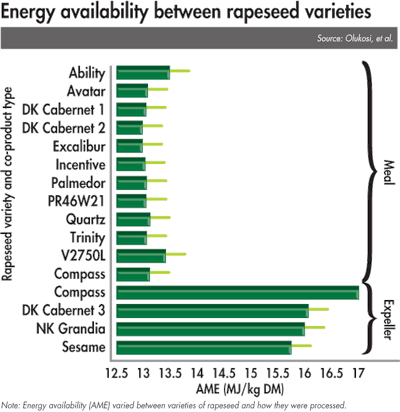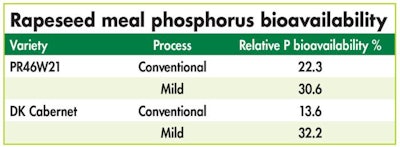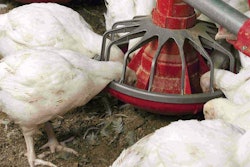
The use of rapeseed meal, or canola meal, has traditionally been limited in poultry and pig diets due to concerns over anti-nutritional factors. However, modern rapeseed varieties have reduced glucosinolate levels. The meal is an excellent source of energy and protein, and has the advantage of being grown domestically.
Rapeseed is a very useful protein source. It is common across Europe and in North America, particularly Canada. While rapeseed meal is not an uncommon ingredient in pig and poultry diets, in recent years there has been a move to increase its inclusion. The main reason for this is sustainability, offsetting the environmental impact of importing soybeans. Cost and availability are other factors that influence the decision to use more homegrown protein sources, particularly when soybean prices are volatile.
The nutritional value of rapeseed co-products used in animal feed may be sensitive to variety as well as the oil-removal process used. More information about these could help nutritionists decide which rapeseed products to buy and increase the use of them in diets for monogastrics — in turn relying less on imported protein crops.
Varieties of rapeseed
There are many varieties of rapeseed grown around the world, which are selected for their yield and suitability to different climates. Most of these are now 00 types, indicating the absence of glucosinolates. It was these anti-nutritional factors that had previously prevented the large-scale use of rapeseed meal in monogastric diets. However, since plant breeding techniques have all but removed them, limitations on inclusion are being reduced.
Commercially, most rapeseed is processed using a conditioning and a cooking step, followed by pressing and solvent extraction. A milder processing technique eliminates one of the cooking steps, reducing the exposure of the meal to heat. There is also a trend for cold-pressed rapeseed oil to be used in place of olive oil in human diets.
The resulting co-product meal from this process has a far greater nutritional value.
The energy content of the meal depends on the level of oil left behind after processing. The most oil is recovered using conventional techniques, utilizing hexane extraction, and the least from cold pressing. Heat can denature the proteins in the meal. Therefore, the amount of heat used in processing techniques will also affect amino acid availability.
Effects of rapeseed variety, processing techniques
A recent investigation by Scotland’s Rural College (SRUC) and the University of Nottingham assessed the effects of rapeseed variety and processing on amino acid digestibility and energy availability. Diets containing 15 different rapeseed meal samples were fed to broilers to determine standardized ileal digestible essential amino acids (SID-eAA) and apparent metabolizable energy (AME). Eleven different varieties were hexane extracted, three were cold pressed and one, Compass, was subject to both processes.
The amino acid digestibility and AME content differed significantly between varieties that had been subject to hexane extraction or cold pressing. For Compass eAA SID (%) was greater in meal resulting from cold pressing, especially for lysine and methionine.

Amino acid availability (SID-eAA) varied between varieties of rapeseed and how they were processed. | Olukosi, et al.
Similarly AME content was 30 percent higher in Compass that had been cold pressed.

Energy availability (AME)varied between varieties of rapeseed and how they were processed. | Olukosi, et al.
“The differences in chemical composition of [oilseed rape] varieties do not massively influence AME because of narrow differences in the chemical components among the varieties,” said Oluyinka Olukosi, a senior research scientist at SRUC. “Previously, we had looked at correlations between AME and compounds including phytic acids, fiber, glucosinolates and tannins.”
He also made the point that where the crop was grown may also affect its chemical composition. For this study, all were grown in the U.K., but climate and soil type will still vary.
Evaluation of the effects of a mild processing method
Different processing methods are being investigated to remove a cooking step and hence reduce the amount of heat required. In this study, two rapeseed varieties were subject to either a conventional or a mild processing technique. The resulting meals were fed to broilers to determine metabolizable energy and phosphorus availability.

Energy availability (AME) was greater for mildly processed rapeseed meal. | Olukosi, et al.
The AME of the conventionally processed rapeseed meal was significantly lower than that from the milder method.

Relative bioavailability for phosphorus (P) was greater for mildly processed rapeseed meal. | Zoe Kay
The relative bioavailability of phosphorus was greater in the meal that had been mildly processed.
“The results show that a milder processing technique had a positive effect on the nutritional value of [rapeseed] meal,” concluded Oluyinka. “Both AME and phosphorus relative availability were lower in rapeseed meal that had been subject to the extra cooking step.”
The combination of varietal and processing effects can also be seen. “The variability in chemical composition that you see in varieties may not predict the way they are affected by processing,” Oluyinka said. “However, when there is uniformity between the types, you may not see big differences in processing effects.”
Commercial implications
The research provides evidence that rapeseed variety and processing technique can greatly influence nutritional value of rapeseed co-products. However, although rapeseed meal has a value, the needs of those using it are not at the forefront of processors' minds. The majority of their revenue comes from selling the oil. Therefore, yield is often the most important consideration for processing techniques.
However, as energy becomes more expensive, analysis of the cost of using an extra heat step versus the extra yield of oil needs to be carried out. Processors are testing different processing methods for this reason. And if milder techniques prove more profitable, then the resulting meal will have a greater nutritional value. This will be great for nutritionists who are looking to use more rapeseed meal in their formulations.
Formulation considerations
The research group at SRUC has used the results from the in vitro trials to carry out animal feeding studies.
“We have fed different varieties processed in different ways to both broilers and pigs,” stated Oluyinka. “The results are not yet published, but I can say that we were able to increase inclusion levels above what is currently used commercially.”
He added that, although they found upper limits for rapeseed meal inclusion, all the broilers were performing above breed standards so, in a commercial situation, even higher levels may still be profitable.
Those using rapeseed meal should encourage processors to investigate different techniques. Animals will benefit from milder techniques, as they are able to utilize the nutrients better. The use of homegrown crops is important for improving the sustainability of pig and poultry production. If recommended inclusion levels can be increased, then significant amounts of soybean meal can be replaced in monogastric diets. And for the processors, making sure this co-product is valued and desired can only be of benefit.
References available on request.


















